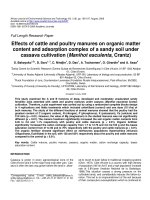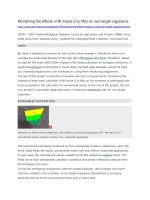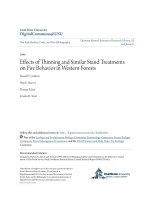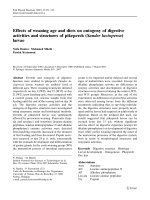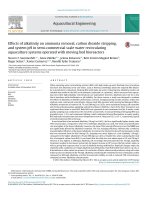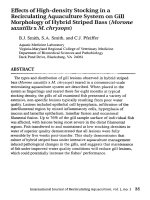Effects of dietary partial replacement of tuna
Bạn đang xem bản rút gọn của tài liệu. Xem và tải ngay bản đầy đủ của tài liệu tại đây (713.98 KB, 4 trang )
Kritsanapuntu et al., J Aquac Res Development 2013, 4:6
/>
Aquaculture
Research & Development
Research
Article
Research
Article
Open
OpenAccess
Access
Effects of Dietary Partial Replacement of Tuna Oil by Corn Oil in
Formulated Diets for Growth Performance and Proximate Composition of
Juvenile Spotted Babylon Babylonia areolata under Hatchery Conditions
Sirusa Kritsanapuntu1, Nilnaj Chaitanawisuti2* and Wannanee Santaweesuk2
1
2
Faculty of Science and Industrial Technology, Prince of Songkhla University, Surattani campus, Amphur Maeung, Surattani province, Thailand
Aquatic Resources Research Institute, Chulalongkorn University, Phya Thai Road, Bangkok, Thailand
Abstract
A 120-day feeding experiment was conducted to determine the effects of dietary partial replacement of tuna oil
by corn oil at different ratios in formulated diets, by which growth performance and proximate composition of juvenile
spotted babylon Babylonia areolata was analyzed. Four isonitrogenous and isolipidic diets were formulated with
10% lipid derived from the following lipid sources: diet A (100% tuna oil without corn oil (control), diet B: 50% tuna
oil and 20% corn oil, diet C: 30% tuna oil and 40% corn oil and diet D: 10% tuna oil and 60% corn oil. This study
showed that all formulated diets were well accepted by the snails throughout the culture period. There were no
significant differences in body weight gain, shell length increment and growth rate among the feeding experiments.
No significant differences were observed in feed conversion ratio among the dietary treatments ranging from 4.35
to 4.77. Survival was high ranging from 98.00% to 100% and no significant differences in survival were observed.
At the end of the experiment, crude protein and fat contents of whole body weight of snails were not statistically
different among the feeding experiments. Crude protein and fat of snails fed four experimental diets ranged from
61.38 to 61.48% and 5.36% to 5.39%, respectively. This study indicated partial replacement of tuna oil by corn oil in
formulated diets have no effects on growth performance but fat content of the whole body reduced to half than those
contained in formulated diets.
Keywords: B. areolata; Formulated diet; Fish oil; Corn oil; Growth;
Survival; Food efficiency
Introduction
Traditional culture of spotted Babylon Babylonia areolata in
Thailand mainly depended on chopped trash fish as the main feed
source for grow out, which is expensive, has limited supply, uncertain
nutritional quality, difficult to store, deteriorates water quality and may
result in the spread of disease [1]. The establishment of a successful
aquaculture industry based on this species requires optimization of
their diet for fast growth, high survival, good food efficiency, and low
cost, whilst providing better biochemical composition in the flesh. The
development of a practical diet for improving the growth performance of
this species is seen as one of the key steps for the successful establishment
of viable spotted Babylon aquaculture venture in Thailand. Then, it is
important to develop a cost-effective and nutritionally balanced feed
formulation for this species in the future [2]. Dietary lipid plays a major
role in providing a source of concentrated energy for growth and as
carriers for fat soluble vitamins. Fish oil contained high quantities of
n-3 HUFA and other essential fatty acids necessary for marine fish and
shellfish. They serve as a functional element maintaining metabolism
and contain attractants that enhance diet palatability [3]. The demand
of fish oils in aquafeeds has dramatically increased and has placed
unsustainable pressure on this finite resource. In the future, global fish
oils production may not be enough to supply the increasing demand of
animal feed. Therefore replacement of fish oil with vegetable oils appears
to be a viable option given their availability, low cost and absence of
diotoxins and pollutants. Thus, the partial replacement of fish oils with
vegetable oils in formulated feeds has gained increasing interest from
aquaculturists [3-6]. Vegetable oils constitute promising candidates
for fish oil replacement, having steadily increasing production, with
high availability and better economic value. Some vegetable oils such
as soybean oil and rapeseed oil are considered as possible alternative
lipid source for freshwater and marine fish [7]. A key requirement
J Aquac Res Development
ISSN: 2155-9546 JARD, an open access journal
for the replacement of fish oil in aquafeeds is to supply equivalent
energy with balanced essential fatty acids. This is necessary in order
to sustain high growth, survival, feed conversion efficiency, immune
competence, disease resistance, and flesh quality. Hence, this study was
designed to determine the effects of partial replacement of tuna oil by
corn oil in formulated diets for the growth performance and proximate
composition of juvenile spotted Babylon Babylonia areolata.
Materials and Methods
Four isonitrogenous, isoenergic and isolipidic experimental diets
were formulated with 10.3% lipid derived from two lipid sources of
tuna oil (TO) and corn oil (CO) as following: diet A (100% TO), diet B
(71.5% TO+28.5% CO), diet C (43% TO+57.0% CO) and diet D (14.5%
TO+85.5% CO). The ingredients used and proximate composition
values of the diets are presented in Table 1. Fish meal served as the
main protein source, while tuna oil and corn oil were used as the lipid
source (Table 1). The dry ingredients were weighted individually and
then thoroughly mixed using an electric grinder. Vitamin and mineral
premixes were mixed separately with cellulose prior to mixing with
other ingredients. Oils were added to the dry ingredients and mixed
*Corresponding author: Nilnaj Chaitanawisuti, Aquatic Resources Research
Institute, Chulalongkorn University, Phya Thai Road, Bangkok, Thailand 10330,
Tel: 668 18021839; Fax: 6622544259; E-mail:
Received August 23, 2013; Accepted September 28, 2013; Published October
08, 2013
Citation: Kritsanapuntu S, Chaitanawisuti N, Santaweesuk W (2013) Effects
of Dietary Partial Replacement of Tuna Oil by Corn Oil in Formulated Diets for
Growth Performance and Proximate Composition of Juvenile Spotted Babylon
Babylonia areolata under Hatchery Conditions. J Aquac Res Development 4: 197
doi:10.4172/2155-9546.1000197
Copyright: © 2013 Kritsanapuntu S, et al. This is an open-access article
distributed under the terms of the Creative Commons Attribution License, which
permits unrestricted use, distribution, and reproduction in any medium, provided
the original author and source are credited.
Volume 4 • Issue 6 • 1000197
Citation: Kritsanapuntu S, Chaitanawisuti N, Santaweesuk W (2013) Effects of Dietary Partial Replacement of Tuna Oil by Corn Oil in Formulated
Diets for Growth Performance and Proximate Composition of Juvenile Spotted Babylon Babylonia areolata under Hatchery Conditions. J
Aquac Res Development 4: 197 doi:10.4172/2155-9546.1000197
Page 2 of 4
Snails were individually weighed every 30 day throughout the
experimental period which lasted for 90 days from March to June, 2011.
For sampling and data collection, fifty snails were randomly sampled
for initial weight and shell length measurement. Weight and shell
length measurement was repeated on day 30, 60, 90 and 120 in order
to determine growth rate of the snails. At the end of the on-growing
period, 12 snails/dietary treatments were sampled for morphometric
measurements (total body weight and total shell length) individually.
Total body weight and total length were measured. Mortality was
determined by counting the number of dead snails and expressing
the results as a percentage of the number of snails at the start of the
experiment. The following indices of growth were calculated at the end
of the experiment: Length increment (LI)=final shell length (cm)-initial
shell length (cm); Weight gain (WG)=final body weight (g)-initial
body weight (g); Absolute growth rate in weight=(final body weight
(g)-initial body weight (g))/T; Absolute growth rate=in weight=final
shell length (cm)-initial shell length (cm))/T; where T=120 days of
culture; Feed conversion ratio (FCR)=feed intake (g)/weight gain (g)
and Survival rate (SR)=100×(final snail number)/(initial snail number).
J Aquac Res Development
ISSN: 2155-9546 JARD, an open access journal
Statistically analyzed data were performed by analysis of variance
(ANOVA) using SPSS program, version 11.5. The effect of different
lipid sources on growth rate, survival and feed conversion ratio data
were subjected to a one-way ANOVA. Duncan’s multiple range test was
used to compare differences between treatment means when significant
F values were observed at P<0.05 level.
Results
Growth performance
Growth in body weight and shell length of juvenile B. areolata fed
on four experimental diets for 90 days was showed in Figure 1. This
study showed that all formulated diets were well accepted by the snails
throughout the culture period. At the end of the growing-out period,
there was no significant differences (P>0.05) in body weight gain, shell
length increment and growth rate among the feeding experiments.
3
Shell length (cm)
Juvenile B. areolata with average initial body weight and shell length
of 0.04 ± 0.01 g and 0.5 ± 0.01 cm used in the feeding experiments
were purchased from a commercial hatchery in Petchaburi, Thailand,
transported to the laboratory and kept in three 300-l circular plastic
tanks for acclimatization. During the acclimatization period, the snails
were fed chopped trash fish. The acclimatization period lasted over 10
days. At the beginning of the experiment, healthy juveniles were sorted
to a uniform size to prevent possible growth retardation of small spotted
Babylon when cultured with larger ones. The animals were weighed to
the nearest 0.01 g using an electronic balance. Homogenous groups
of 1,620 juveniles were distributed randomly into eight rectangular
rearing tanks of 55.0×30.0×30.0 cm (3 tanks/diet) at a density of 300
snails per m2 supplied (50 snails/tank) with flow-through ambient
seawater system with a constant flow rate of 150 l per hour. The bottom
of the rearing tank was covered with coarse sand as substratum at 1.0
cm thickness. Water depth in rearing tank was 20 cm. The tanks were
provided with a supplemental aerator stone and water was aerated
daily for 20 h. Light was maintained on a 12:12 h light cycle. Water
temperature was maintained at 29 ± 2°C by controlling the ambient
temperature and salinity held at 30 ppt through the addition of well
water. Water quality parameters were as follows: dissolved oxygen
>6.50 mg/l, total ammonia nitrogen <0.30 mg/l, nitrite <0.45 mg/l and
pH ≥ 7.8. At the beginning of the feeding experiments, juveniles were
hand-fed to apparent visual satiation at once daily (10:00 h) with one
of the experimental diets. The amount of feed was adjusted daily based
on the amount of food consumed by snails within 0.5 h the previous
day to ensure that only a minimal amount of feed was left. Satiation
was determined from observation of the point at which snails ceased
active feeding, moved away from the feeding area and buried under
sand substratum. Uneaten food was siphoned out daily after the snails
stopped eating to prevent water degradation. The aquaria were cleaned
weekly by siphoning 3/4th of the water to remove excess feed and faecal
matter and by scrubbing the sides of the aquarium. No chemical or
antibiotic agent was used throughout the entire experimental period.
Grading by size was not carried out in any pond throughout the
growing - out period.
The whole body tissue samples from each dietary treatment were
analyzed for proximate composition (crude protein, crude fat, ash and
carbohydrate). The tissue samples were minced and a portion removed
for moisture and ash content. Moisture was determined by drying pre
weighed samples in porecelain cups at 104°C for 24 h, and then ash was
determined by incinerating the dried samples at 500°C for 12 h. The rest
of the whole tissue was lyophilized and used for crude protein and fat
analyses. The protein content was determined by the Kjeldahl method
and the fat by Soxhlet extraction with petroleum ether according to
the standard methods of AOAC [8]. All analyses were performed in
triplicate.
2.5
2
Diet A
1.5
Diet B
1
Diet C
0.5
Diet D
0
0
30
60
90
120
Time (days)
3
Total weight (g)
again. Water was added and the moist mixture was hand-kneaded
until it formed stiff dough. It was pelleted using a hand mincer fitted
with a 3 mm die, stored in high-gauge plastic bags and preserved in
a refrigerator. Proximate analysis of feed was carried out following
standard methods [8].
2.5
2
Diet A
1.5
Diet B
1
Diet C
0.5
Diet D
0
0
30
60
90
120
Time (days)
Diet A (100% Tuna oil),
Diet B (71.5% Tuna oil+28.5% Corn oil),
Diet C (43% Tuna oil+57.0% Corn oil)
Diet D (14.5% Tuna oil+85.5% Corn oil).
Figure 1: Growth in shell length and body weight of juvenile B. areolata fed
different experimental diets for 120 days.
Volume 4 • Issue 6 • 1000197
Citation: Kritsanapuntu S, Chaitanawisuti N, Santaweesuk W (2013) Effects of Dietary Partial Replacement of Tuna Oil by Corn Oil in Formulated
Diets for Growth Performance and Proximate Composition of Juvenile Spotted Babylon Babylonia areolata under Hatchery Conditions. J
Aquac Res Development 4: 197 doi:10.4172/2155-9546.1000197
Page 3 of 4
Ingredients
(g/kg diet)
Proximate composition
Diet no. (% tuna oil/% corn oil)
Diet A
(100/0)
Diet B
(71.5/28.5)
Diet C
(43.0/57.0)
Diet D
(14.5/85.5)
Fish meal
410.0
410.0
410.0
410.0
190.0
Soy bean meal
190.0
190.0
190.0
Shrimp meal
30.0
30.0
30.0
30.0
Wheat
170.0
170.0
170.0
170.0
Wheat gluten
70.0
70.0
70.0
70.0
Vitamin mixa
20.0
20.0
20.0
20.0
Mineral mixb
20.0
20.0
20.0
20.0
Cellulose
20.0
20.0
20.0
20.0
Tuna oil
70.0
50.0
30.0
10.0
Corn oil
0
20.0
40.0
60.0
Proximate composition (%)
Crude protein
39.98 ± 0.20
40.04 ± 0.07
40.01 ± 0.04
40.08 ± 0.05
Crude lipid
10.42 ± 0.05
10.38 ± 0.05
10.39 ± 0.04
10.36 ± 0.02
Fiber
2.19 ± 0.06
2.21 ± 0.03
2.21 ± 0.03
2.2 ± 0.03
Water content
13.20 ± 0.04
13.22 ± 0.04
13.24 ± 0.05
13.29 ± 0.02
Ash
14.29 ± 0.07
14.27 ± 0.04
14.29 ± 0.03
14.29 ± 0.05
Vitamin premix (mg kg-1 or IU): vitamin A, 10000000 IU; vitamin D3, 1000000 IU;
vitamin E, 10000 mg kg-1; vitamin K3, 1000 mg kg-1; vitamin B1, 500 mg kg-1; vitamin B2, 5000 mg kg-1; vitamin B6, 1500 mg kg-1; vitamin C, 10000 mg kg-1; folate,
1000 mg kg-1; dealmethionine, 16038 mg kg-1
b
Mineral premix (mg kg-1): Ca, 147 g kg-1; P, 147 g kg-1; Fe, 2010 mg kg-1; Cu, 3621
mg kg-1; Zn, 6424 mg kg-1; Mn, 10062 mg kg-1; Co, 105 mg kg-1; I, 1000 mg kg-1;
Se, 60 mg kg-1
a
Table 1: Ingredients and proximate composition of the experimental diet.
Parameters
Diet no. (% tuna oil/% corn oil)
Diet A
(100/0)
Diet B
(71.5/28.5)
Diet C
(43.0/57.0)
Diet D
(14.5/85.5)
Initial shell length (cm)
0.5 ± 0.01
0.5 ± 0.01
0.5 ± 0.01
0.5 ± 0.01
Initial body weight (g)
0.04 ± 0.01 0.04 ± 0.01
0.04 ± 0.01
0.04 ± 0.01
Final shell length (cm)
2.34 ± 0.14 2.44 ± 0.02
2.47 ± 0.08
2.38 ± 0.14
Final body weight (g)
2.24 ± 0.03 2.44 ± 0.18
2.63 ± 0.35
2.47 ± 0.46
Shell length increments 1.84 ± 0.14 1.94 ± 0.02
(cm)
1.97 ± 0.08
1.88 ± 0.14
Body weight gains (g)
2.24 ± 0.03 2.47 ± 0.22
2.87 ± 0.21
2.47 ± 0.47
Absolute growth rate
(cm mo-1)
0.46 ± 0.03 0.49 ± 0.05
0.49 ± 0.02
0.47 ± 0.04
Absolute growth rate
(g mo-1)
0.56 ± 0.05 0.62 ± 0.06
0.72 ± 0.05
0.62 ±0.12
Feed conversion ratio
4.65 ± 0.21 4.64 ± 0.19
4.77 ± 0.20
4.35 ± 0.17
98.00
98.00
Final survival rate (%)
98.00
100
Diet A (100% Tuna oil),
Diet B (71.5% Tuna oil+28.5% Corn oil),
Diet C (43% Tuna oil+57.0% Corn oil)
Diet D (14.5% Tuna oil+85.5% Corn oil).
Table 2: Growth parameters (mean ± SE) of juvenile B. areolata fed different
experimental diets for 90 days.
Body weight gains were 3.28, 3.36, 3.41 and 3.37 g/snail for snails fed
diet 1, 2, 3 and 4, respectively, and those of shell length increments were
1.84, 1.93, 1.98 and 1.87 cm/snail, respectively. The absolute growth rate
in shell length were 0.46, 0.49, 0.49 and 0.47 cm/month for snails fed
diet 1, 2, 3 and 4, respectively, and those of body weight gains were
0.56, 0.62, 0.72 and 0.62 g/month, respectively (Table 1). No significant
differences (P>0.05) were observed in feed conversion ratio among the
dietary treatments ranging from 4.35 to 4.77 (Table 2). Survival was
high ranging from 98.00% to 100% and no significant differences in
survival were observed (P>0.05). The shell length and body weight
relationship of juvenile B. areolata fed on four experimental diets for
120 days was showed in Table 3.
J Aquac Res Development
ISSN: 2155-9546 JARD, an open access journal
At the end of the experiment, crude protein and fat contents of
whole body weight of snails were not statistically different (P>0.05)
among the feeding experiments. Crude protein and fat contents of four
experimental diets were not statistically different (P>0.05) ranging
from 39.98% to 40.08% and 10.36% to 10.42%, respectively (Table 1).
However, crude protein and fat contents of whole body weight for snails
fed four experimental diets were not statistically different (P>0.05)
(Table 4). Crude fat content of whole body is a half less than those
contained in formulated diets. Crude protein and fat of snails fed four
experimental diets ranged from 61.38 to 61.48% and 5.36% to 5.39%,
respectively.
Discussion
The present study demonstrates that all formulated diets were well
accepted by the snails throughout the culture period. There was no
significant differences in body weight gain, shell length increment and
growth rate among the feeding experiments. No significant differences
were observed in feed conversion ratio among the dietary treatments
ranging from 4.35 to 4.77. Survival was high ranging from 98.00% to
100% and no significant differences in survival were observed. At the
end of the experiment, crude protein and fat contents of whole body
weight of snails were not statistically different among the feeding
experiments. Crude protein and fat of snails fed four experimental
diets ranged from 61.38 to 61.48% and 5.36% to 5.39%, respectively.
This study indicated partial replacement of tuna oil by corn oil in
formulated diets did not effect on growth performance. This study
was agreed with various investigations in marine finfish and shellfish
[3,6,7]. Hu et al. [6] reported that there were no significant differences
in body weight gain among juvenile Litopenaeus vannamei fed practical
diets containing different ratios of menhaden oil, soybean oil, and
soybean lecithin. Regost et al. [4] reported that replacement of fish oil
by vegetable oils (soybean oil and linseed oil) is possible with negligible
impact on growth performance of juvenile turbot Psetta maxima and
dietary lipids are an effect vector to influence the nutritional quality
of fish product. Fountoulaki et al. [7] reported that growth and feed
utilization in gilthead sea bream Sparus aurata are not affected by fish
oil substitution with soybean and rapeseed oil, contrary to palm oil
Test diets
Equations
R2
Diet A
W=-0.8530 L1.1201
0.6550
Diet B
W=-4.0227 L2.6575
0.7099
Diet C
W=-4.2884 L2.7964
0.7942
Diet D
W=-3.1713 L2.3802
0.7179
Diet A (100% Tuna oil),
Diet B (71.5% Tuna oil+28.5% Corn oil),
Diet C (43% Tuna oil+57.0% Corn oil)
Diet D (14.5% Tuna oil+85.5% Corn oil).
Table 3: Length and weight relationship of juvenile B. areolata fed different
experimental diets for 90 days.
Parameters
Diet no. (% tuna oil/% corn oil)
Diet A
(100/0)
Diet B
(71.5/28.5)
Diet C
(43.0/57.0)
Diet D
(14.5/85.5)
Crude protein (%)
61.38 ± 0.02 61.45 ± 0.01 61.48 ± 0.01
61.39 ± 0.01
Crude lipid (%)
5.36 ± 0.03
5.37 ± 0.02
5.39 ± 0.01
5.36 ± 0.04
Diet A (100% Tuna oil),
Diet B (71.5% Tuna oil+28.5% Corn oil),
Diet C (43% Tuna oil+57.0% Corn oil)
Diet D (14.5% Tuna oil+85.5% Corn oil).
Table 4: Nutritional values of whole body tissues of juvenile B. areolata fed different
experimental diets for 90 days (mean ± SE).
Volume 4 • Issue 6 • 1000197
Citation: Kritsanapuntu S, Chaitanawisuti N, Santaweesuk W (2013) Effects of Dietary Partial Replacement of Tuna Oil by Corn Oil in Formulated
Diets for Growth Performance and Proximate Composition of Juvenile Spotted Babylon Babylonia areolata under Hatchery Conditions. J
Aquac Res Development 4: 197 doi:10.4172/2155-9546.1000197
Page 4 of 4
inclusion. Richard et al. [3] concluded that replacing 60% of fish oil by
the two mixture of vegetable oils (linseed oil and palm oil) in the feeds of
European seabass fingerlings Dicentrachus labrax until they reached the
size of 160 g has no marked effect on growth performance, lipogenesis
and tissue lipid uptake but has a hypocholesterolemic effect. Peng et
al. [5] indicated that complete substitution of fish oil with soybean oil
reduced growth efficiency for black seabream Acanthopagrus schlegeli.
Thus, 60-80% replacement of fish oil by soybean oil is recommended in
diet formulation for black seabream. Piedecausa et al. [9] showed that
the replacement of fish oil with soybean or linseed oil in sharpsnout
seabream (Diplodus puntazzo) does not affect growth or feed utilization
after three months of feeding. Vegetable oils also increased the muscle
content of linoleic and linolenic acids. In addition, in terms of economic
performance, the soybean oil diet was the least expensive diet, and had
the best economic conversion ratio. In conclusion, this study shows that
it is possible to substitute almost 50% of fish oil by corn oil in diets for
in juvenile B. areolata. Fish oil can be replaced by corn oil in juvenile
B. areolata for a period of 120 days without negatively affecting growth
performance and feed utilization. However, it would be interesting to
analyze the effects of incorporating this oil in diets for longer periods of
time. In addition, more investigation should be continued to reply the
question that can vegetable oil replacement at different ratios modify
the snail muscle fatty acid profile, reducing/ increasing the levels of
EPA, DHA, ARA.
Acknowledgment
This study was supported by the National Research Council of Thailand
(NRCT), who provided fund for this research in the fiscal year 1996-2011. We are
especially grateful to Associated Professor Dr. Somkiat Piyatiratitivorakul, Faculty
of Science, Chulalongkorn University for his encouragement and critical reading of
the manuscript.
References
1. Chaitanawisuti N, Kritsanapuntu S (2000) Growth and production of hatchery-
reared juvenile spotted babylon, Babylonia areolata Link 1807 cultured to
marketable sizes in intensive flowthrough and semi-closed recirculating water
systems. Aquac Res 31: 415-419.
2. Chaitanawisuti N, Kritsanapuntu S, Natsukari Y (2002) Economic analysis of a
pilot commercial production for spotted babylon Babylonia areolata (Link 1807),
marketable sizes using a flow-through culture system in Thailand. Aquac Res
33: 1265-1272.
3. Richard N, Mourente G, Kaushik S, Corraze G (2006) Replacement of a large
portion of fish oil by vegetable oils does not affect lipogenesis, lipid transport and
tissue lipid uptake in European seabass (Dicentrachus labrax L.). Aquaculture
261: 1077-1087.
4. Regost C, Arzel J, Robin J, Rosenlund G, Kaushik S (2003) Total replacement
of fish oil soybean or linseed oil with a return to fish oil in turbot (Psetta
maxima) 1. Growth performance, flesh fatty acid profile, and lipid metabolism.
Aquaculture 217: 465-482.
5. Peng S, Chen L, Qin JG, Hou J, Yu N, et al. (2008) Effects of replacement of
dietary fish oil by soybean oil on growth performance and liver biochemical
composition in juvenile black seabream Acanthopagrus schlegeli. Aquaculture
276: 154-161.
6. Hu Y, Tan B, Mai K, Ai Q, Zhang L, et al. (2011) Effects of dietary menhaden
oil, soybean oil and soybean lecithin oil at different ratios on growth, body
composition and blood chemistry of juvenile Litopenaeus vannamei. Aquacult
Int 19: 459-473.
7. Fountoulaki E, Vasilaki A, Hurtado R, Grigorakis K, Nengas I, et al. (2009) Fish
oil substitution by vegetable oils in commercial diets for gilthead sea bream
(Sparus aurata L.); effects on growth performance, flesh quality and fillet fatty
acid profile: Recovery of fatty acid profiles by a fish oil finishing diet under
fluctuating water temperatures. Aquaculture 289: 317-326.
8. AOAC (1990) Official methods of analysis, 15th edn. Association of Official
Analytical Chemists, Arington, VA, 1298 pp.
9. Piedecausa MA, Mazon MJ, Garcia BG, Hernandez MD (2007) Effects of total
replacement of fish oil by vegetable oils in the diets of sharpsnout seabream
(Diplodus puntazzo). Aquaculture 263: 211-219.
Submit your next manuscript and get advantages of OMICS
Group submissions
Unique features:
•
•
•
User friendly/feasible website-translation of your paper to 50 world’s leading languages
Audio Version of published paper
Digital articles to share and explore
Special features:
Citation: Kritsanapuntu S, Chaitanawisuti N, Santaweesuk W (2013) Effects of Dietary
Partial Replacement of Tuna Oil by Corn Oil in Formulated Diets for Growth Performance
and Proximate Composition of Juvenile Spotted Babylon Babylonia areolata under Hatchery
Conditions. J Aquac Res Development 4: 197 doi:10.4172/2155-9546.1000197
J Aquac Res Development
ISSN: 2155-9546 JARD, an open access journal
•
•
•
•
•
•
•
•
250 Open Access Journals
20,000 editorial team
21 days rapid review process
Quality and quick editorial, review and publication processing
Indexing at PubMed (partial), Scopus, EBSCO, Index Copernicus and Google Scholar etc
Sharing Option: Social Networking Enabled
Authors, Reviewers and Editors rewarded with online Scientific Credits
Better discount for your subsequent articles
Submit your manuscript at: />
Volume 4 • Issue 6 • 1000197

